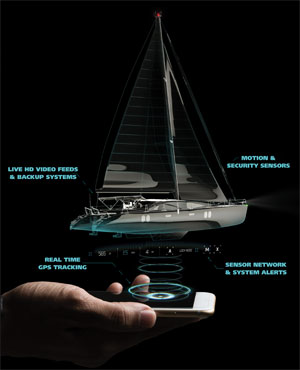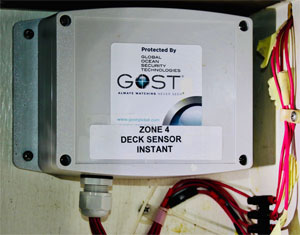Sailing around the world for more than 12 years, through more than 50 countries, it seems we have been lucky to have not lost anything to thieves. But we feel one’s luck runs out at some point, and the worst will eventually happen. Rather than paying an insurance premium, we put that money into upgrading and maintaining our boat in a seaworthy condition. This year, our “insurance budget” paid for installing a real marine security system to protect our equipment and us from people who may be determined to carry our things away.
Dinghy outboards have always been targets, as have cellphones and cash, but now thieves are also very interested in marine electronics, scuba gear and other treasures found on most cruising sailboats — not to mention the boat itself.
It is time for cruisers, not just superyachts, to take the lead from landlubbers and beef up security aboard our boats. Otherwise, many of us will pay the price. People ashore lock their homes and cars, and have security alarms and services, yet many sailboats leave hatches open and doors unlocked while blissfully asleep in paradise. Innocence is waning though; over the recent years, tightening of security on cruising sailboats has been a trend.
Even modest sailboats like ours are a treasure ship when viewed from the life of many villagers. In so many ways, YouTube channels and generous yachties worldwide advertise the relative wealth on board sailboats. Opportunistic thieves may think that most yachties have possessions to spare. Unfortunately, the very things that many of us barely afford and appear like fancy toys to those on shore, are actually for safety — from navigation consoles, satellite phones and fishfinders, to laptops and iPads. Losing them is not just a financial hit but also one that can endanger our safety and ability to sail onward. We are often in locations where purchasing locally or flying in replacements is a near impossible or expensive task. And when word gets around that we were robbed, and that we were then able to go out and replace those things a month later because we “need them,” a message is communicated that most of us can afford to quickly replace these items.
We felt that investing in a serious anti-theft system would be cheap insurance; the value of one moderate chartplotter exceeds the price of one great security system. Camera equipment, stereos, computers, outboard engines — we could be ruined by what thieves could grab in just half an hour.
Home-brewed security
In the past few years, we got by with cheap wireless cameras and burglar alarms, both packaged and home-brewed. But, our handyman security left too many blind spots and kept us home to play security guards instead of seeing the world we sailed so far to see.
Our requirements for a new system were as follows:
 |
|
A collection of “home-grown” alarm system parts previously employed by the Childresses. |
|
Rebecca Childress |
• A system that did not need Wi-Fi or cellular connectivity to be fully operational. We often anchor in dodgy towns that are not near cellular towers, and we need to be protected everywhere. Cellular is a nice backup, but it should not be the primary method used to receive messages, arm the boat or contact authorities in any security system. Dodgy cellular means dodgy security. And any world cruiser knows how frequently there is spotty cellular, let alone no cellular service at all.
• Motion detectors and/or cameras that would not false alarm because of the cat, the rocking of the boat, birds, boats, leaves or laundry. YouTube has countless videos showing alarm systems that triggered when the sun came up, or a speedboat left the anchorage rocking, or a bird landed on the binnacle. It would not be acceptable to have our ship’s cat setting off alarms.
• Very low amperage draw: A system that could be left on full time but comes with its own backup battery system should power be cut or compromised.
• Wired where necessary/recommended, but otherwise wireless as much as possible to save on installation effort and the number of holes drilled. We would not sacrifice reliability for the sake of easier installation. We promised ourselves to listen to what the experts recommended, who in turn would listen to all of our questions and provide viable solutions with knowledge specific to sailboats.
• High reliability in a marine environment. Our boat takes a beating, gets wet, and any system we get must be ready for this. We didn’t want a home security system repurposed by the marketing department. This system needed to be specifically for boats, tested and true, nearly waterproof, slamming-waves-proof and salty-humidity-proof.
• Barely visible from inside or outside of the boat, yet effective enough to set off alarms before a thief gets to the point of breaking the boat to get in.
• Able to activate bright lights, strobe lights and disturbingly loud, nauseating alarms if someone boards or goes near any entrance to the boat from any direction.
 |
|
A diagram from GOST showing elements of the company’s alarm and monitoring system. |
|
Courtesy GOST |
• Capable of arming the boat while away, and also able to set active outside-only sensors when we are inside the boat.
• Internet/app access to the security system via satellite so we could know its current status when we are away — even when the boat is nowhere near Wi-Fi or cellular.
• Able to send alerts to local authorities by satellite whether the boat is in cellular range or not.
• The option to expand and grow the system in the future. We didn’t want to have to buy a whole new system to accommodate a new sensor.
• Everything in one — i.e., not three separate systems to arm and keep up with.
• The ability to specifically protect our outboard engine on deck, as this is a constant high-theft item. We lift and lock the dinghy engine every night, but we wanted extra protection for this or other things on deck, fully integrated as part of the complete system.
• Excellent technical support and a strong warranty by a reputable company who’s here for the long haul!
• We actually can’t imagine anyone stealing our boat. However, we have started to read accounts of boats smaller than ours being stolen. We decided it would be nice if the system could track outright theft of the boat, and involve the authorities quickly. The same function could serve us well if the boat decided to take a walkabout around the harbor by itself while it’s at anchor and we are ashore.
 |
|
A GOST deck sensor unit. |
|
Rebecca Childress |
Everything in one system
It was difficult to get everything we wanted all in one system. Some systems were primarily boat systems monitors, but not very strong on the security aspect. Others would have a sensor we wanted most but absolutely nothing else, no ability to expand in the future or poor support. Others tried to tell us what they wanted us to have and didn’t listen to what we felt we needed specific to our boat and situation. If a company couldn’t support us in the purchasing stage, how could it possibly get better after they had our money?
Only one company had everything on our wish list but, of course, it also had the highest price of all the systems. We opened our pocketbook wide and made an order with Global Ocean Security Technologies, or GOST (www.GOST.com). The company doesn’t do home systems; they deal only in superyachts, poweryachts, luxury sailboats, speedboats and ordinary sailboats like ours. They have a stellar reputation for security systems on boats worldwide.
The folks at GOST preconfigured a lot of the system for us, modifying the system to make it affordable and specific for our needs. (Full disclosure: GOST did provide us with additional components in return for consideration in our articles and YouTube videos. However, we had already made a decision to buy their system prior to receiving any additional components). GOST also graciously allowed us to install the system ourselves, which it never does. This may possibly be due to Patrick’s stellar ideas in his “home-brewed security” video (youtu.be/pi0zpy7CH5o), or possibly from aptitude in his other how-to videos and articles.
There were countless possibilities with GOST. We spent hours on Skype with the team at GOST deciding exactly what made sense for a boat like ours. The company’s website shows many of the options, but anything becomes possible in a conversation with GOST, and modifications can both reduce and increase the prices tremendously. Let the team know your budget up front, and they can likely create the best package for your individual boat’s layout as well as recommend the best installer.
What did we get?
For the base system, we purchased the simplest but still sophisticated next-generation Universal Control Unit (UCU), which includes many new features including lower power draw, DC cutoff to protect the vessel’s batteries, dual battery backup, a broadened 10-32VDC input voltage, and an easier but more feature-rich user interface. It is the only system on the market offering security, monitoring, tracking and surveillance integrated together in just one system.
This UCU can operate over both cellular and Inmarsat geostationary satellite networks, allowing for true global coverage. It includes a full-function app for off-site control to arm/disarm and control any DC or AC device, while allowing notification via push notifications and SMS text messages. Local arming features still include utilization of the key fob or optional user-friendly 5- or 7-inch touch-screen keypads in addition to the app. The next-generation UCU can communicate with up to 32 sensors, five AC/DC devices and 32 users/key fobs. The system includes completely independent wireless door/hatch contacts, infrared beam sensors, deck pressure sensors and high water sensors, as well as DC battery low voltage, AC shore power loss and smoke detectors, just to name a few. The internal LTE/4G/3G communicator provides cellular control with the app as well as text messaging. Additionally, the UCU can work with any existing onboard Internet via its third-party CAT5 Ethernet plug, as GOST recognizes that many boats already have Internet access and there is no need to pay for a second cellular/VSAT connection.
This system utilizes GOST’s Nav-Tracker GPS and Inmarsat antenna, enclosed in an IP67-rated (water resistant) enclosure with a backup power supply. We went without the optional display/keypad unit just to save a tiny bit on power consumption, but mostly to save money. We can even add local law enforcement contact details and set them up to receive all the reports coming out of the unit while the event is unfolding, which is a great feature. The system utilizes Inmarsat satellites for all communication and control so that we are not reliant on cellular connectivity, though it does have a built-in, quad-band GPRS/GSM with dual SIM card slots offering simultaneous push notifications, emails and text message reporting and control when within GSM cellular range.
 |
|
An illustration of how under-deck sensors can pick up foot pressure from intruders on deck. |
|
Rebecca Childress |
The “inputs” can include up to 32 sensors, wired or wireless. Some of the sensors have separate control units powered by the vessel’s batteries, while others are self-powered with batteries that must be changed each year. We opted for several simple but extra-wide gap hatch opening magnet sensors so we can leave windows slightly ajar for air but still be protected, as well as a pet-immune, dual-beam motion sensor for inside. (The companies we were impressed with recommended against outside motion detectors on at least a monohull, since reliability would be lacking due to constant boat movement). We also have a great pull sensor integrated in the system that will protect our dinghy and other stern-rail objects quite simply, conveniently and completely wirelessly.
But, our favorite — and a quite unique — sensor, which was not offered in most marine security systems, is the deck pressure sensor. Since we have easy access to our decks from below, we are able to epoxy these small noninvasive sensors anywhere below our deck, in all the places intruders would have to step on in order to board or access hatches. They are miniature “land mines” that “blow up” when someone steps anywhere near them. They can operate very reliably and effectively on any deck material or thickness in wet, windy, dry, sunny, cold and hot weather alike. They even differentiate when a bird has landed, a dog or monkey has jumped aboard or a jerry can has fallen over, versus when a human has walked on them. This is a very tried-and-true technology, having been used on superyachts for decades. These sensors weighed very heavily in our decision since we want to deter thieves well before they start breaking windows to get in.
Next, we chose a number of “outputs,” which include multiple loud alarms, sirens, horns and various light configurations that will flash and shriek like an NYC discotheque, suggesting an entire police squad is on the way. Most are either onboard lights or horns we already have from previous systems, but there are a few — like the wireless strobe light and an additional siren or two — that will make a thief lingering on board not only too conspicuous, but also nauseous, in pain and unable to carry out their original intentions.
Two modes of operation
We will be programming the system so that there are at least two different modes: “staying on board” arming for when we are sleeping but want the deck, outboard and hatch entries armed; and another “fully armed” mode for when we want everything turned on. The system also offers two partitions — essentially, two completely independent security systems under one roof, like one for crew and one for the owners.
If the boat were to be stolen or drift out of its “geofence” area that we define, the system will let us know and police will easily track the culprit, even if they head out to sea on our boat. This is particularly valuable, since no matter what one’s financial standing is, a boat is usually someone’s most valuable asset — and, for many of us, our full-time home.
Well into the future, we can add all kinds of additional monitoring and security sensors. We can control all DC and AC devices on board like lights, air conditioning, the heat or the stereo. We can add a keypad and things like that awesome cloaking system or acoustic barrier. We can add hidden stationary or revolving cameras and recorders, as well as FLIR night vision, even on top of the mast. The possibilities are extensive with this system.
We don’t insure Brick House, but we spend money and time to keep her safe and seaworthy. Installation of this high-end security system represents another step in “self insuring.” Our new GOST UCU security system will be watching on Brick House but never be seen — unless you stop by for a demonstration in the middle of the night.
Rebecca Childress is a marine writer who voyages aboard the Valiant 40 Brick House with her husband, Patrick. Their blog is at whereisbrickhouse.com.

